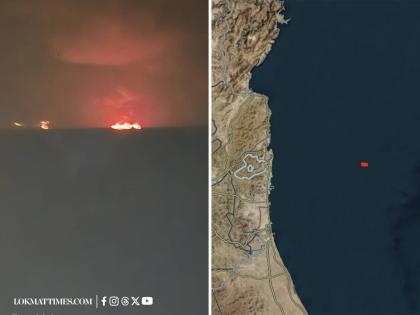Oil Tankers Collide and Catch Fire Near Hormuz as Electronic Jamming Rises Due To Iran-Israel Conflict
By Lokmat English Desk | Updated: June 17, 2025 17:01 IST2025-06-17T16:59:52+5:302025-06-17T17:01:05+5:30
Two oil tankers caught fire after a collision near the Strait of Hormuz. In that location, it is being ...

Oil Tankers Collide and Catch Fire Near Hormuz as Electronic Jamming Rises Due To Iran-Israel Conflict
Two oil tankers caught fire after a collision near the Strait of Hormuz. In that location, it is being reported that electronic interference has surged during the conflict between Iran and Israel. In this incident, no casualties have been reported till now. There is no sign of spillage as well. Iran and Israel have been firing missiles at each other since June 13. This has disrupted navigation systems near the vital sea route between Iran and Oman, which handles a huge portion of the world’s oil supply.
Following the collision 24 nautical miles off the eastern coast, the United Arab Emirates Coast Guard reported that it had evacuated 24 passengers from one of the ships, the Adalynn, to the port of Khor Fakkan. Following a fire on its deck, the Oslo-listed business Frontline announced that the crew of the second tanker, the Front Eagle, was safe and that no pollution was observed.
TankerTrackers.com, a tracking service, reports that the Front Eagle was travelling to Zhoushan, China, carrying two million barrels of Iraqi crude oil on board. According to the monitoring agency, the Adalynn, a Suezmax-class tanker owned by Global Shipping Holding Ltd. of India, was headed for the Suez Canal in Egypt with no cargo. The agency posted details on its official X handle.
Incident Report: Collision in the Gulf of Oman (2025-06-17 at 25.2869, 56.79017)
— TankerTrackers.com, Inc. (@TankerTrackers) June 17, 2025
Vessels Involved:
FRONT EAGLE (9855343)
- Size Class: VLCC Supertanker
- Cargo: Approximately 2 million barrels of Iraqi crude oil
- Destination: Zhoushan, China
ADALYNN (9231767)
- Size Class:… pic.twitter.com/9WuTrMiNlb
The Front Eagle was travelling south at 13.1 knots when it "executed a starboard (right) turn, resulting in a collision with the port quarter (aft port side)" of the Adalynn, which was travelling southeast at 4.8 knots, said TankerTrackers.com in its post on X. The Arabian Sea lies beyond the Strait of Hormuz, which connects the Gulf to the northwest with the Gulf of Oman to the southeast. Approximately 17.8 million to 20.8 million barrels of oil, condensate, and gasoline passed through each day between the beginning of 2022 and last month, according to Vortexa data.
In an advisory this week, the JMIC information centre of the multinational, U.S.-led Combined Maritime Force reported receiving allegations of electronic interference from the Gulf region, including the area around Iran's Port of Bandar Abbas. In response to pressure from the West, Tehran has already threatened to block travel in the strait. Iran has not responded to claims of electronic interference or the crash that occurred on Tuesday.
Open in app